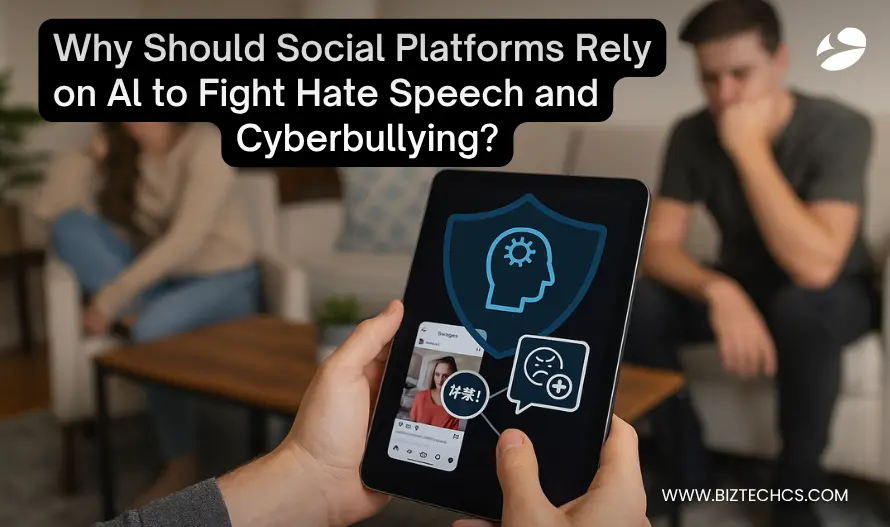
https://www.biztechcs.com/blog/why-should-social-platforms-rely-on-ai-to-fight-hate-speech-and-cyberbullying/
Nearly half of social media users lose sleep over encountering harmful content online, with 45% of U.S. teens saying that social media platforms negatively impact the amount of sleep they get, according to a 2024–25 survey by the Pew Research Center.
Social platforms today play whack-a-mole with billions of posts daily, while trolls evolve faster than a virus in a petri dish. The old manual moderation approach works about as well as using a teaspoon to bail out the Titanic.
Enter artificial intelligence, the digital bouncer that never sleeps, never gets tired, and definitely never rage-quits after reading the thousandth conspiracy theory about birds being government drones.
Real-time harmful content detection systems now scan, analyze, and neutralize toxic posts before your morning coffee gets cold. They’re transforming the wild west of social media into a civilized environment.
Smart platforms are partnering with MVP app development companies specializing in AI for hate speech and cyberbullying prevention. The result? Machines can now spot trouble faster than humans can type “first” in the comments section.
Why Is Manual Content Moderation No Longer Sufficient for Modern Social Media Platforms?
Manual moderation simply can’t keep pace with the speed, volume, and complexity of today’s user-generated content, making it an increasingly outdated defense against online chaos.
The Scale Problem
Facebook alone processes over 4 billion posts daily while human moderators review content at roughly the speed of a sloth on sedatives. (source)
A single moderator can realistically review about 200 pieces of content per day before their brain becomes scrambled from exposure to the internet’s darkest corners. Meanwhile, users upload 500 hours of video to YouTube every minute. To keep up with that pace, a platform would need as many moderators as the entire population of Texas. However, with AI/ML development services, content moderation can be automated, significantly reducing the need for human intervention while enhancing accuracy and speed in identifying inappropriate content.
The average response time for removing harmful content after it appears is 24 hours. That’s plenty of time for a spicy conspiracy theory to go viral and convince half the internet that calculators are sentient.
The Cost Factor
Hiring human moderators costs platforms approximately $500 million annually, and that’s just for keeping the bare minimum of sanity online. Every time user growth spikes by 10%, moderation costs skyrocket, much like popcorn in a microwave, because humans don’t scale as efficiently as servers.
Training new moderators takes six weeks, during which they are questioned about every life choice that led them to scroll through humanity’s worst impulses professionally.
The turnover rate is a staggering 150% a year. After all, spending eight hours a day watching people be awful to each other isn’t what anyone dreamed of growing up.

Platform executives often ask: ‘What’s the actual cost of transitioning from human to AI moderation without losing our existing quality standards?’ The answer involves more math than a calculus final.
Still, you’re looking at about 3–6 months of running both systems in parallel while the AI learns your platform’s unique brand of chaos. Working with an experienced MVP app development company can streamline this transition, reducing both time and implementation risks.
The Accuracy Challenge
Two moderators reviewing the same post agree only 58% of the time, making consistency about as reliable as weather predictions in April. What counts as offensive in one culture might be considered a form of comedy in another, leaving moderators playing cultural referee without a clear rulebook.
Language barriers compound the chaos when a moderator fluent in English tries decoding whether that Hindi comment is a death threat or grandma’s secret curry recipe.
Context flies out the window faster than common sense at a flat-earth convention. That’s why legitimate historical discussions get banned while actual hate speech slips through—just because someone spelled it creatively.
What Makes AI-Based Content Moderation Tools Essential for Platform Safety?
AI-powered moderation has become a critical layer of defense for digital platforms, ensuring harmful content is stopped before it can impact users or brand safety.
Real-Time Detection Capabilities
AI systems scan text, images, and videos faster than a teenager exits a family dinner conversation about their future. Real-time harmful content detection catches problematic posts within milliseconds, before they spread like gossip at a corporate merger announcement.
BiztechCS, an AI Development Company, can implement AI for hate speech and cyberbullying prevention that identifies threats before they materialize, kind of like having a psychic bouncer who actually works. The pattern recognition catches evolving slang, coded language, and those creative misspellings trolls use to bypass filters. It’s now harder for troublemakers to outsmart the system than it is to explain cryptocurrency to your accountant.
But here’s what keeps platform owners up at night: ‘Won’t AI flag legitimate content as harmful and anger our user base?’
Fair concern. Initially, false positives occur at a rate of around 8–12%, but within six months, machine learning reduces this to under 3%. That’s better than human moderators—who, after their third coffee, can’t even agree with themselves 42% of the time.
AI Expert Tip: Feed your AI system with platform-specific examples of violations from your historical moderation decisions. BiztechCS has found that training models on 10,000+ labeled examples from your actual user base improves accuracy by 40% compared to generic pre-trained models. Update training data weekly to catch emerging slang and bypass techniques.
Scalability Benefits
AI moderation handles millions of posts simultaneously without needing coffee breaks, mental health days, or therapy sessions after reading comment sections.
The cost per moderated item drops from $0.50 with humans to $0.001 with AI, making CFOs happier than finding a tax loophole. These systems operate around the clock without overtime pay, sick leave, or complaints about having to review another flat-earth debate at 3 AM.
Scaling up means adding servers, not recruiting an army of humans willing to wade through the internet’s cesspool for minimum wage plus trauma. C-suite executives invariably wonder: ‘How quickly can we implement AI moderation without disrupting current operations?’
BiztechCS typically deploys basic AI moderation within 4–6 weeks, with full integration achieved in about three months. That’s faster than most companies finish arguing about the budget in committee meetings—and definitely quicker than explaining to shareholders why your platform became a toxic wasteland.
Ready to slash moderation costs by 70% while actually improving response times? Your platform’s transformation could begin sooner than you think.
How Do AI Content Moderation Systems Actually Work?
AI moderation tools combine language processing, image recognition, and behavior tracking to keep online spaces safer without slowing down user experience.
Text Analysis Technology
Text analysis technology has evolved from reading emotions like a nosy neighbor peering through blinds to actually understanding context better than your lawyer understands billable hours.
Modern NLP systems catch everything from passive-aggressive Slack messages to real-time harmful content detection across dozens of languages, making them the Swiss Army knife of digital communication monitoring.
These algorithms now grasp nuance and sarcasm so well, they’d probably understand your mother-in-law’s backhanded compliments about your cooking. At the same time, AI for hate speech and cyberbullying prevention works around the clock like a digital bouncer who never needs a coffee break.
Visual Content Recognition
Computer vision examines your platform’s content like a forensic accountant on Red Bull, catching inappropriate pixels faster than employees delete browser history when IT walks by.
AI Development Company develops real-time harmful content detection systems that scan video frames, blur faces, and flag violations, ensuring that AI for hate speech and cyberbullying prevention actually works before your platform becomes the next PR nightmare.
These systems identify problematic content hiding in memes and videos more effectively than legal teams find loopholes, protecting users while your MVP app development company scales without turning into a digital dumpster fire.

Behavioral Pattern Analysis
BiztechCS monitors user behavior, much like your credit card company watches for suspicious charges, catching troublemakers faster than HR spots someone job hunting on company time.
Additionally, it implements AI for hate speech and cyberbullying prevention that actually works. The system identifies spam, bots, and harassment patterns with the accuracy of a divorce lawyer finding hidden assets. It can distinguish between real humans and bot armies better than bouncers can spot fake IDs from genuine ones.
Real-time harmful content detection becomes child’s play when algorithms recognize coordinated attacks before comment sections turn into digital fight clubs where nobody follows the first rule.
Stakeholders frequently ask: ‘How does AI moderation integrate with our existing tech stack without breaking everything?’ The beautiful part is that modern AI systems plug into existing APIs, much like LEGO blocks, designed by engineers who actually communicate with each other, requiring minimal backend changes.
In contrast, your legacy systems continue to run. This is similar to the one printer from 2003 that somehow still works, despite everyone’s hatred for it.
What Industries and Platforms Benefit Most from AI Content Moderation?
AI-powered moderation isn’t a one-size-fits-all solution—it has varying impacts across industries where user-generated content, real-time interaction, and brand safety intersect.
Social Media Platforms
Meta moderates billions of posts like a caffeinated octopus juggling chainsaws, while X needs real-time harmful content detection that catches toxic tweets faster than gossip spreads after layoffs. Instagram’s AI analyzes filtered photos with the paranoia of forensic accountants on stimulants.
At the same time, TikTok’s AI for hate speech and cyberbullying prevention processes are challenged by dance challenges and mental breakdowns filmed vertically at speeds that make market crashes look slow.
BiztechCS can implement systems across these platforms that monitor chaos more effectively than auditors during tax season. Each platform has its own unique brand of insanity, where creativity and catastrophe collide more fiercely than egos at shareholder meetings.
The scale of moderation required makes manual review about as practical as using Excel for cryptocurrency mining, forcing platforms to rely on ai/ml development services that never sleeps, never complains, and never asks for stock options.
Gaming Communities
Gaming chat toxicity flows faster than excuses during layoffs, with players unleashing verbal creativity that would make nuclear waste jealous. In contrast, voice chat filtering requires AI that understands rage-screaming better than therapists understand billionaire problems.
BiztechCS can create systems that track player behavior patterns, much like forensic accounting reveals embezzlement, effectively distinguishing between competitive banter and genuine harassment, and preventing players from rage-quitting after losing.
Tournament integrity needs stronger protection than NDAs at product launches, catching cheaters who try harder than companies to avoid taxes, while griefers destroy games like hostile takeovers destroy company culture.
Real-time processing handles in-game chat, voice communication, and suspicious behavior simultaneously. It works overtime—like interns during busy seasons—to spot irregularities faster than auditors find discrepancies in expense reports, where milliseconds matter more than quarterly projections.
Gaming platform leaders consistently worry: ‘Will aggressive AI moderation kill the competitive banter that makes gaming culture unique?’
The system learns to distinguish between “your strategy sucks” (acceptable trash talk) and actual threats more quickly than players learn new meta strategies. It preserves gaming culture while removing genuine toxicity—like having a bouncer who knows the difference between playful shoving and a real bar fight.

AI Expert Tip: Create game-specific moderation profiles rather than blanket policies across your platform. BiztechCS develops separate AI models for competitive shooters versus casual puzzle games, adjusting tolerance levels accordingly. Include professional gamers and community moderators in training data labeling—their input improves context recognition by 35% for gaming-specific language.
Educational Platforms
Educational platforms need more protective measures than helicopter parents at kindergarten graduation. AI monitors student interactions, much like compliance officers, searching for violations and predatory behavior. Meanwhile, IT teams review browser histories for potential concerns.
BiztechCS can develop age-appropriate content filtering with more precision than calculating stock options. It ensures kindergarteners don’t stumble upon graduate-level material while maintaining boundaries stricter than non-compete agreements.
Academic integrity monitoring detects plagiarism more quickly than legal teams identify copyright infringement. It can recognize original work from copied content just as experienced managers spot exaggerations in résumés during hiring season.
The system protects students while detecting cheating attempts more sophisticated than creative accounting. It makes learning environments safer than board meetings after layoff announcements—where student protection actually matters, unlike most corporate mission statements.
Is your educational platform struggling to balance academic freedom with student safety? There’s a way to protect learners without stifling legitimate educational discourse.
E-commerce and Marketplaces
Fake reviews get spotted faster than employees pretending to work when bosses walk by. At the same time, fraudulent listings are flagged faster than suspicious expenses on company cards. The AI can recognize scams that would otherwise make pyramid schemes look legitimate.
BiztechCS can create verification systems that more effectively separate authentic customer feedback from bot-generated praise, helping investors recognize pump-and-dump schemes. Each listing is scrutinized more thoroughly than lawyers review prenuptial agreements.
When partnering with an MVP app development company that understands marketplace dynamics, these verification systems can be deployed incrementally, testing effectiveness before full-scale implementation.
Customer communication monitoring catches scammers trying to take transactions offline faster than employees pocket office supplies. It identifies phishing attempts disguised as customer service better than spam filters that catch Nigerian princes.
The detection system operates around the clock, much like paranoid security guards at a warehouse. It prevents more damage than most insurance policies would ever cover when things inevitably go sideways—because every transaction deserves protection stronger than a witness protection program.
Closing Lines
The days of treating content moderation like a game of digital whack-a-mole are as outdated as floppy disks at a cloud computing conference. Platforms that still rely solely on human moderators are essentially bringing butter knives to a nuclear war.
AI for hate speech and cyberbullying prevention isn’t just nice to have anymore. It’s as essential as passwords that aren’t “password123,” especially when the internet generates toxic content faster than startups burn through venture capital. The sweet spot lies in hybrid approaches, where ai/ml development services handles the bulk of the work.
At the same time, humans provide the context that machines miss, such as understanding why a seemingly innocent eggplant emoji has just violated seventeen community guidelines.
Continuous improvement keeps these systems sharper than passive-aggressive office emails, adapting to new forms of digital nastiness that emerge daily like mutant strains of stupidity.
Real-time harmful content detection delivers ROI that makes even the stingiest CFOs loosen their purse strings faster than employees grabbing free pizza at lunch meetings. BiztechCS stands ready to build these digital defense systems that protect communities, while platforms focus on growth.
After all, letting trolls run wild on your platform is about as smart as using company funds to invest in NFTs of celebrity toenails.
The future of online safety isn’t about choosing between humans and machines, but about making them work together like a well-oiled machine that can distinguish between free speech and hate speech.
Are you ready to transform your platform from a moderation nightmare into a thriving, safe community? The technology exists, the ROI is proven, and your users are waiting.
27 Nov, 2025
5 min read







